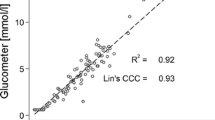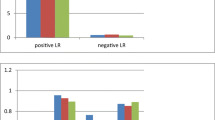Abstract
Current diagnostic methods in differentiating septic from non-septic arthritis are time-consuming (culture) or have limited sensitivity (Gram stain). Microcalorimetry is a novel method that can rapidly detect microorganisms by their heat production. We investigated the accuracy and time to detection of septic arthritis by using microcalorimetry. Patients older than 18 years of age with acute arthritis of native joints were prospectively included. Synovial fluid was aspirated and investigated by Gram stain, culture and microcalorimetry. The diagnosis of septic arthritis and non-septic arthritis were made by experienced rheumatologists or orthopaedic surgeons. Septic arthritis was diagnosed by considering the finding of acute arthritis together with findings such as positive Gram stain or positive culture of synovial fluid or positive blood culture. The sensitivity and specificity for diagnosing septic arthritis and the time to positivity of microcalorimetry were determined. Of 90 patients (mean age 64 years), nine had septic arthritis, of whom four (44 %) had positive Gram stain, six (67 %) positive synovial fluid culture and four (44 %) had positive blood culture. The sensitivity of microcalorimetry was 89 %, the specificity was 99 % and the mean detection time was 5.0 h (range, 2.2–8.0 h). Microcalorimetry is an accurate and rapid method for the diagnosis of septic arthritis. It has potential to be used in clinical practice in diagnosing septic arthritis.

Similar content being viewed by others
References
Geirsson AJ, Statkevicius S, Víkingsson A (2008) Septic arthritis in Iceland 1990–2002: increasing incidence due to iatrogenic infections. Ann Rheum Dis 67(5):638–643
Mathews CJ, Weston VC, Jones A, Field M, Coakley G (2010) Bacterial septic arthritis in adults. Lancet 375(9717):846–855
Mathews CJ, Kingsley G, Field M, Jones A, Weston VC, Phillips M, Walker D, Coakley G (2007) Management of septic arthritis: a systematic review. Ann Rheum Dis 66(4):440–445
Faraj AA, Omonbude OD, Godwin P (2002) Gram staining in the diagnosis of acute septic arthritis. Acta Orthop Belg 68(4):388–391
Goldenberg DL (1998) Septic arthritis. Lancet 351(9097):197–202
Söderquist B, Jones I, Fredlund H, Vikerfors T (1998) Bacterial or crystal-associated arthritis? Discriminating ability of serum inflammatory markers. Scand J Infect Dis 30(6):591–596
Coutlakis PJ, Roberts WN, Wise CM (2002) Another look at synovial fluid leukocytosis and infection. J Clin Rheumatol 8(2):67–71
Margaretten ME, Kohlwes J, Moore D, Bent S (2007) Does this adult patient have septic arthritis? JAMA 297(13):1478–1488
Braissant O, Wirz D, Göpfert B, Daniels AU (2010) Use of isothermal microcalorimetry to monitor microbial activities. FEMS Microbiol Lett 303(1):1–8
Trampuz A, Salzmann S, Antheaume J, Daniels AU (2007) Microcalorimetry: a novel method for detection of microbial contamination in platelet products. Transfusion 47(9):1643–1650
Baldoni D, Hermann H, Frei R, Trampuz A, Steinhuber A (2009) Performance of microcalorimetry for early detection of methicillin resistance in clinical isolates of Staphylococcus aureus. J Clin Microbiol 47(3):774–776
Braissant O, Müller G, Egli A, Widmer A, Frei R, Halla A, Wirz D, Gasser TC, Bachmann A, Wagenlehner F, Bonkat G (2014) Seven hours to adequate antimicrobial therapy in urosepsis using isothermal microcalorimetry. J Clin Microbiol 52(2):624–626
Furustrand Tafin U, Meis JF, Trampuz A (2012) Isothermal microcalorimetry for antifungal susceptibility testing of Mucorales, Fusarium spp., and Scedosporium spp. Diagn Microbiol Infect Dis 73(4):330–337
Borens O, Yusuf E, Steinrücken J, Trampuz A (2013) Accurate and early diagnosis of orthopedic device-related infection by microbial heat production and sonication. J Orthop Res 31(11):1700–1703
Yang S, Ramachandran P, Hardick A, Hsieh YH, Quianzon C, Kuroki M, Hardick J, Kecojevic A, Abeygunawardena A, Zenilman J, Melendez J, Doshi V, Gaydos C, Rothman RE (2008) Rapid PCR-based diagnosis of septic arthritis by early Gram-type classification and pathogen identification. J Clin Microbiol 46(4):1386–1390. doi:10.1128/JCM.02305-07
Bonilla H, Kepley R, Pawlak J, Belian B, Raynor A, Saravolatz LD (2011) Rapid diagnosis of septic arthritis using 16S rDNA PCR: a comparison of 3 methods. Diagn Microbiol Infect Dis 69(4):390–395
Conflict of interest
The authors declare that they do not have any conflict of interest.
Financial disclosure
None.
Author information
Authors and Affiliations
Corresponding author
Rights and permissions
About this article
Cite this article
Yusuf, E., Hügle, T., Daikeler, T. et al. The potential use of microcalorimetry in rapid differentiation between septic arthritis and other causes of arthritis. Eur J Clin Microbiol Infect Dis 34, 461–465 (2015). https://doi.org/10.1007/s10096-014-2248-y
Received:
Accepted:
Published:
Issue Date:
DOI: https://doi.org/10.1007/s10096-014-2248-y




